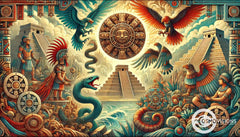Aztec Warfare: Conquest Strategies and Military Tactics of Aztec Warriors
Posted by Massimiliano Geraci

Warfare was at the heart of Aztec society. Every man, from farmers to nobles, stood ready for battle. Their reasons ranged from seeking tribute and land to capturing foes for religious sacrifice.
In Aztec history, warfare, military training, and sacrifice were deeply intertwined. The Aztecs fought not only to expand but to satisfy their gods.
One key fact stands out: the sun and war god, Huitzilopochtli, demanded blood sacrifices to keep rising each day. This belief drove the Aztecs into continuous warfare.
Our article explains how this fierce need shaped their military tactics and daily life. We explore everything from training young boys in combat schools to elaborate flower wars designed for capture rather than kill.
Get ready for a journey back in time…
Key Takeaways
1. Aztec society trained every man, including farmers and nobles, for warfare to expand their land and capture enemies for sacrifice to their gods.
2. Warrior societies like the Jaguar and Eagle Warriors were elite groups in the Aztec military. They earned respect through bravery in battles and played a key role in religious ceremonies by capturing enemies for sacrifices.
3. The Aztecs used strategic intelligence, gathering information about their enemies through espionage and diplomacy. This helped them plan conquests or defend their territories effectively.
4. Weapons such as bows, darts, spears, and clubs made from obsidian were essential to Aztec warriors. These tools reflected the deep connection between warfare practices and spiritual beliefs in Aztec society.
5. The Flower Wars were planned conflicts whose main goals were capturing prisoners for sacrifice to gods like Huitzilopochtli, ensuring the sun would rise again, and maintaining cosmic balance.
The Aztec Army: Structure and Training
The Aztec soldiers, including the elite warriors, joined special clubs based on their skills and acts of bravery. To move up the ranks, they had to capture enemies in battle.
Warrior societies
Warrior societies in Aztec culture were elite groups, each with their own unique symbols and gods. They earned respect and higher ranks through acts of bravery on the battlefield. Young warriors trained rigorously, often starting from a tender age in special camps designed for military education.
These societies included the fierce Jaguar Warriors and the noble Eagle Warriors. Both carried weapons inset with sharp obsidian and wore animal-themed armor to symbolize their rank and unit.
Acts of valor were not just about fighting; they connected deeply to Aztec spirituality.
These units played a crucial part in warfare strategies and religious ceremonies in Tenochtitlan, the heart of the Aztec empire. Capturing enemies for sacrifice was as critical as winning battles, making these warriors central figures in maintaining military dominance and divine favor with gods like Huitzilopochtli.

Ranks and promotion
Earning a rank in the Aztec army meant showing bravery and skill in battle. The higher ranks wore unique items like special feathered caps, cloaks, and accessories to show their status.
These symbols made them stand out among other soldiers. To move up, warriors had to capture enemies during warfare. This was very important for their honor.
The king, called a tlatoani, led as the top commander with his second-in-command by his side. Together, they decided who would earn new titles or move up in rank. Young fighters trained hard from a young age, dreaming of one day wearing those grand feathers and jewels that marked true leaders and heroes in Aztec society.
Aztec Military Tactics
Aztec warriors used clever plans to win battles. They gathered secrets about their enemies and chose the perfect time to strike.
Strategic intelligence
Espionage and diplomacy led the charge in Aztec warfare, setting a foundation for aggression only when necessary. This approach allowed them to gather vital information about enemy strengths, weaknesses, and intentions without direct conflict.
They valued intelligence from traders and allies who moved freely among foes. These informants were eyes and ears on the ground, essential for planning conquests or defending their dominions.
In the shadows of trade routes lay the power of empires; knowledge was both shield and spear.
Their military leaders used this knowledge to make informed decisions, ensuring that when battle was unavoidable, it favored Aztec victory. Spies blended with local populations long before tensions peaked into warfares—gathering insights on everything from political unrest to terrain advantages.
Such strategic prowess underscored their conquests, turning potential threats into opportunities for expansion or alliances with city-states yet unconquered by their empire's reach.
Combat strategies
Aztec warriors faced their enemies at dawn, ready with plans of ambush and feigned retreats. Such tactics were not mere acts of war but a dance with the divine, as capturing foes alive held sacred importance in most Aztec warfare, particularly during flower wars aimed at taking sacrificial captives.
This ritual warfare aimed to secure captives for sacrifice to the gods, especially Huitzilopochtli, maintaining cosmic balance and ensuring victory in future battles. The battlefield was an altar where each step and strategy unfolded like a prayer, woven deeply into the spiritual fabric of Aztec society.
The exchange of missiles marked the beginning of combat—a shower of darts and stones setting the stage for close-quarters battle. Warriors advanced under cover of this barrage, hearts set on conquest and capture rather than outright slaughter.
By employing surprise attacks from hiding spots or faking weakness to lure enemies into traps, they demonstrated profound understanding of both physical terrain and human psychology.
These maneuvers reflected their beliefs in strategy over strength. They honored their deities through military prowess while navigating the tangible world’s challenges with astute preparation and adaptability.

Weapons and Armor Used by Aztec Warriors
Aztec fighters carried strong clubs and sharp spears into battle. They wore cotton armor and carried shields for protection.
Rituals and ceremonies surrounding the deaths of fallen warriors were an integral part of Aztec culture.
Ranged weapons
Bows and projectiles were common ranged weapons wielded by Aztec warriors. These tools allowed them to strike at foes from a distance, adding a strategic advantage to their combat tactics.
Warriors skilled in these arms played critical roles in battles, enabling strikes against opponents before they could close in for melee combat.
Using bows and darts, Aztec soldiers showcased their mastery of ranged warfare—a fundamental part of Aztec military strategy. This proficiency not only demonstrated the strength and skill of the warrior but also reflected the deep connection between Aztec society, warfare practices, and spiritual beliefs.
Through mastery of ranged weaponry, warriors sought favor with the gods—earning honor on Earth and promises of glory in the afterlife.
Melee weapons
Aztec warriors used close-combat tools like sticks and pointy spears in battle. These tools were simple but deadly, especially made from sturdy wood or stone. Elite fighters often decorated their gear with bright feathers and skins from wild animals, showing off their skills and victories.
This mix of practicality and display underlines the deep connection between warfare, personal achievement, and spiritual beliefs within the Aztec civilization.
Spears and clubs weren't just weapons; they were symbols of a warrior's strength and his bond with the gods. The sharp edges of obsidian blades could easily tear through enemy armor, making these weapons feared on the battlefield.
Such gear enabled Aztec soldiers to capture enemies for sacrifices, pleasing their deities. These practices highlight how combat was woven into every aspect of Aztec life, blending physical prowess with religious dedication.
The Significance of Flower Wars in Aztec Warfare
Flower Wars played a key role in Aztec warfare. They were a type of ceremonial warfare practiced by the Aztecs. These conflicts were carefully arranged combats between the Aztecs and their enemies, with the main goal of capturing prisoners for sacrifice.
This practice was deeply rooted in Aztec religious beliefs, particularly worshipping Huitzilopochtli, their sun god. The sacrifices made during these wars were thought to ensure the sun would rise again and maintain balance in the world.
The inauguration of the Templo Mayor in Tenochtitlan is a stark testament to the scale of such practices—20,000 lives offered up in sacrifice. Through these Flower Wars, warrior societies within Aztec culture gained prestige, and individual warriors could ascend in rank by capturing enemies.
This complex interplay of religious duty, military training, and societal structure highlights how integral Flower Wars were not just to warfare but to maintaining cosmic order and social hierarchy within Aztec society.

The Impact of Aztec Warfare on their Downfall
Aztec armies faced a harsh reality in 1519. Their ways of fighting did not match the European tactics brought by Spanish forces. This difference played a huge role in their defeat.
The Aztecs had fought bravely, using weapons and strategies perfected over centuries. Yet, these methods were designed for different kinds of battles, often within central Mexico or against similar foes, reflecting the rich Mesoamerican cultures of the region.
In 1521, Tenochtitlan, the heart of the Aztec empire, fell to invaders. This was not just a loss of land but a crushing blow to their entire way of life. The city’s fall marked the end of an era for Aztec society as it struggled under new rule.
Once feared and respected throughout Mesoamerica, their military practices could not save them from this fate.
Warfare shaped the Aztec empire, from its warriors' bravery to the gods' demands. Every man stood ready for battle, driven by faith and a need for captives. Their military skills and tactics were advanced, and they used clubs, bows, and spears expertly.
The fall of this mighty civilization came as they faced foes with different fighting styles. Thus ends the tale of Aztec warfare—a blend of courage, faith, and strategy that etched their name in history.
Explore our deep dive into Aztec construction techniques and architecture to discover how formidable Aztec engineering shaped their cities and influenced their battlefield strategies.
FAQs
1. What made Aztec warriors so fierce?
Aztec warriors, trained from the age of ten and grouped into elite units like the jaguar and eagle warriors, were fierce due to their rigorous training in basic military tactics and their belief in Aztec gods. They wore splendid feather war costumes which showed their role and achievements.
2. How did the Aztecs use weapons in battle?
The Aztecs used various weapons, including bows, arrows, spears, and clubs edged with sharp obsidian blades. These first weapons were crucial for sacrificing captives to the gods.
3. Why was warfare important to the Aztecs?
Warfare was fundamental to Aztec society as it expanded their empire, supplied captives for sacrifice to please the gods like Huitzilopochtli, and played an essential part in daily life by influencing the economy and social structure.
4. Did all Aztecs fight in wars?
Yes, everyone in Aztec society had a role in warfare; even commoners could rise through military ranks based on their bravery and the number of captives they took. This system tied success in battle directly with societal status within Tenochtitlan.
5. What happened to those captured by Aztec warriors?
Those captured by Aztec warriors would be brought back to Tenochtitlan where they might be sacrificed at the main temple or kept alive depending on various factors such as religious festivals or political reasons.
6. How did human sacrifice play a part in warfare?
Human sacrifice was an integral part of both warfare strategies among the ancient Mexica people because it appeased powerful deities who controlled fate's threads... Capturing enemies for this purpose drove many military campaigns—believing these acts ensured cosmic balance while reinforcing power structures within Tenochtitlan itself.





















